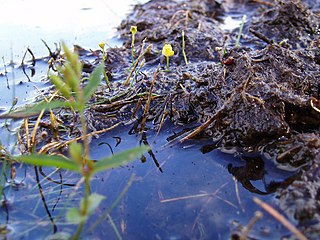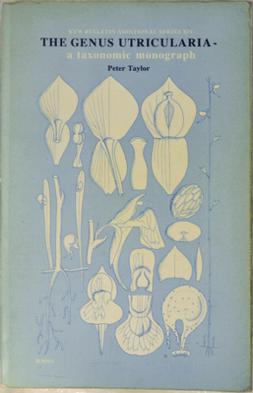
Utricularia gibba, commonly known as the humped bladderwort or floating bladderwort, is a small, mat-forming species of carnivorous aquatic bladderwort. It is found on all continents except Antarctica.

Utricularia geminiscapa, the hiddenfruit bladderwort, is a perennial, medium-sized species of aquatic bladderwort. This species occurs naturally in the northeastern United States and Canada with one record from British Columbia in Western Canada. A small population is present near Westport in New Zealand where the species is thought to have recently naturalized- it was first recorded in this area in 1975.

Utricularia pusilla, the tiny bladderwort, is an annual, terrestrial carnivorous plant that belongs to the genus Utricularia. Its distribution includes ranges in Mexico, the Caribbean and Central and South America: specifically in Argentina, Belize, Bolivia, Brazil, Colombia, Costa Rica, Cuba, Dominica, the Dominican Republic, Ecuador, French Guiana, Guatemala, Guyana, Honduras, Jamaica, Nicaragua, Panama, Paraguay, Peru, Puerto Rico, Surinam, Trinidad and Tobago, and Venezuela.

Utricularia subulata, the zigzag bladderwort, is a small annual, terrestrial carnivorous plant that belongs to the genus Utricularia. It is the most widely distributed species in the genus, being almost pantropical.

Utricularia resupinata, popularly known as lavender bladderwort or northeastern bladderwort, is a small perennial subaquatic carnivorous plant that belongs to the genus Utricularia. It is native to eastern Canada, the United States, and Central America. This plant species has an interesting etymology, growth pattern, ecology, and research history. As a plant that is threatened or endangered in many of the States where it is found, it is a candidate for sound conservation efforts.
Utricularia floridana, the Florida yellow bladderwort, is a large affixed aquatic carnivorous plant in the bladderwort genus within the bladderwort family). It is a perennial plant that is endemic to southeastern United States.

Utricularia foliosa, the leafy bladderwort, is a large suspended aquatic carnivorous plant that belongs to the genus Utricularia. It is probably a perennial plant that cultivates in lake, swamps and ponds. U. foliosa is native to Africa and North and South America, widely distributed among many countries. Although, they are widely distributed around the world, very little studies have been contributed to U. foliosa. They like to sprout all year long, and found in large body of water. The environment that Utricularia foliosa are found in are experiencing negative anthropogenic impacts such as drainage and conversion to urban or agricultural activities are causing rapid environmental degradation.

Utricularia macrorhiza, the common bladderwort, is a perennial suspended aquatic carnivorous plant that belongs to the genus Utricularia. U. macrorhiza is native to North America and eastern temperate Asia.

Utricularia minor, the lesser bladderwort, is a small species of perennial carnivorous plant in the family Lentibulariaceae. It is usually found affixed to the substrate but it can also survive suspended in a body of water. U. minor is a circumboreal species and is found in North America, Asia, and Europe.

Utricularia intermedia, the flatleaf bladderwort or intermediate bladderwort is a small, perennial carnivorous plant that belongs to the genus Utricularia. It is usually found affixed to the substrate but it can also survive suspended in a body of water. U. intermedia is a circumboreal species and is found in North America, Asia, and Europe.

Utricularia ochroleuca, the yellowishwhite bladderwort, pale bladderwort, or cream-flowered bladderwort, is a small, perennial carnivorous plant that belongs to the genus Utricularia. It is usually found affixed to the substrate. U. ochroleuca is a circumboreal species and is found in North America, Asia, and Europe.

Utricularia olivacea, the piedmont bladderwort, is a very small, annual suspended aquatic carnivorous plant that belongs to the genus Utricularia. Utricularia olivacea is native to Central America, South America, the West Indies, and the eastern United States.

Utricularia radiata, the little floating bladderwort, is a medium-sized suspended aquatic carnivorous plant that belongs to the genus Utricularia. U. radiata is endemic to North America.

Utricularia striata, the striped bladderwort, is a medium-sized affixed subaquatic carnivorous plant that belongs to the genus Utricularia. U. striata is endemic to the eastern coastal plains of the United States.
Utricularia stygia, the arctic bladderwort or Northern bladderwort, is an affixed aquatic carnivorous plant that belongs to the genus Utricularia. U. stygia is native to northern Europe and North America. This species was originally published by Göran Thor in 1987 but the description was not in Latin and was therefore nomenclaturally invalid. Thor validly published the species a year later. The cited difference that separates U. stygia from U. ochroleuca is the shape of the tiny quadrifid glands inside the bladders, specifically at which angle the "arms" of these glands diverge from one another. Thor, when working on the Utricularia of Sweden noted that this distinction alone allowed for consistent species identification. Both Barry Rice and Peter Taylor have expressed concerns regarding how this method applies to other populations around the world.

Utricularia purpurea, the eastern purple bladderwort, is a medium-sized suspended aquatic carnivorous plant that belongs to the genus Utricularia. U. purpurea is endemic to North and Central America. It has been suggested that U. purpurea may have partially lost its appetite for carnivory. Richards (2001) did an extensive study in the field on it and noted that trapping rates of the usual Utricularia prey were significantly lower than in other species in the genus. Richards concludes that this species can still trap and digest arthropod prey in its specialized bladder traps, but does so sparingly. Instead, it harbors a community of algae, zooplankton, and debris in the bladders that indicates U. purpurea favors a mutualistic interaction in place of a predator–prey relationship.

Utricularia cornuta, the horned bladderwort, is a small to medium-sized, probably perennial species of carnivorous plant in the family Lentibulariaceae. It is endemic to North America and can be found in the Bahamas, Cuba, Canada, and the United States. Utricularia cornuta grows as a terrestrial or subaquatic plant in marshes, swamps, and pools in shallow waters, mostly at lower altitudes. It was originally described and published by André Michaux in 1803.

Utricularia juncea, the southern bladderwort, is a small to medium-sized, probably perennial carnivorous plant that belongs to the genus Utricularia. U. juncea is native to Central, South, and North America. It grows as a terrestrial plant in marshes, swamps, and pools in shallow waters, mostly at lower altitudes. It was originally described and published by Martin Vahl in 1804.
Utricularia simulans, the fringed bladderwort, is a small to medium-sized, probably perennial, carnivorous plant that belongs to the genus Utricularia. U. simulans is native to tropical Africa and the Americas. It grows as a terrestrial plant in damp, sandy soils in open savanna at altitudes from near sea level to 1,575 m (5,167 ft). U. simulans was originally described and published by Robert Knud Friedrich Pilger in 1914.

The Genus Utricularia: A Taxonomic Monograph is a monograph by Peter Taylor on the carnivorous plant genus Utricularia, the bladderworts. It was published in 1989 by Her Majesty's Stationery Office (HMSO) as the fourteenth entry in the Kew Bulletin Additional Series. It was reprinted for The Royal Botanic Gardens, Kew in 1994.


















